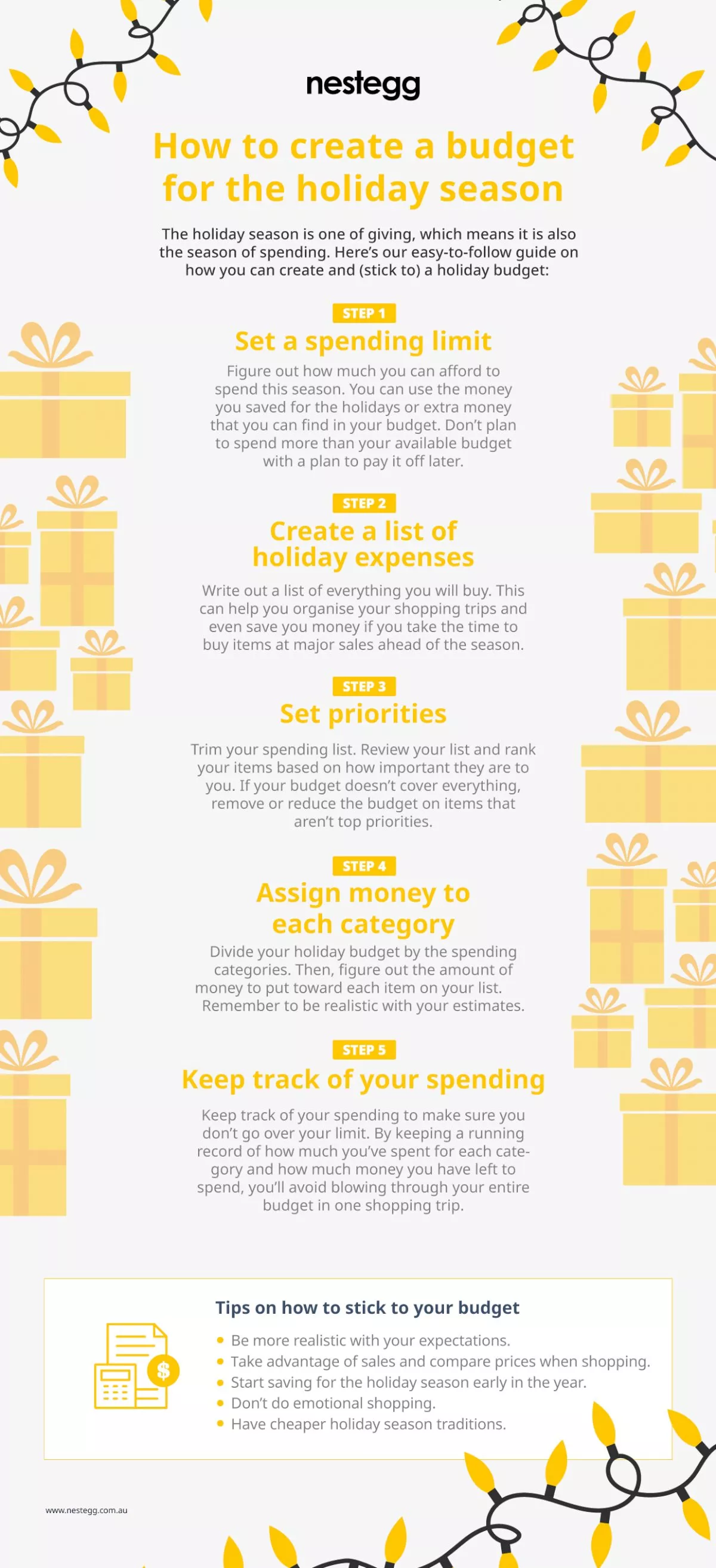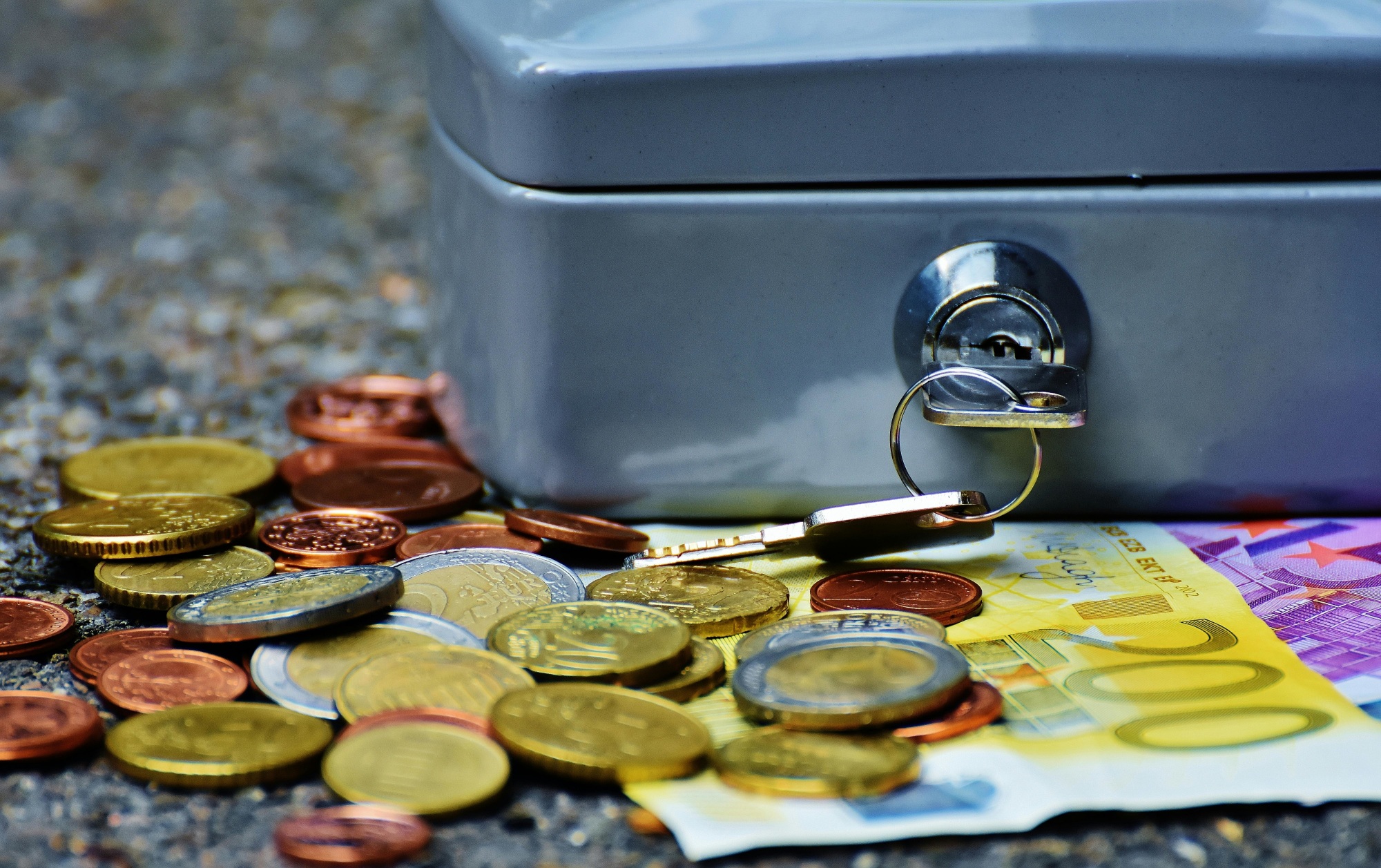How to create a budget for the holiday season

The holiday season can certainly take a toll on your wallet. And it’s not entirely surprising; the season of giving is usually seen as the season of spending. The average Australian household is seen to set aside a $500 budget for gift giving during the holiday season. And while recent economic downturns have weakened consumers’ appetite for holiday shopping, it doesn’t completely deter them from spending.
The spending doesn’t stop with gifts. The holidays come with a long list of other expenses, including food, decorations, holiday travel and charitable donations. At the end of the season, you can easily spend up to thousands of dollars on Christmas, Hanukkah, Kwanzaa or whatever holidays you celebrate and face the new year with empty pockets or a significant credit card debt.
Let’s take the stress out of the holiday season by helping you create (and stick) to a holiday budget. Not only will a spending plan lessen your stress, but also keep your finances in check and prevent you from racking up debt this holiday season.
How to create a holiday season budget
The process of making a holiday budget is similar to creating a household budget. The best time to do it is early on before the holiday season is in full swing. Going into the season with your budget prepped and ready will make the holiday season more enjoyable.
Step 1: Set a spending limit
First, figure out how much you can afford to spend this season. It’s ideal for the amount to come from your available cash and savings so you don’t need to take on debt to get through the holiday season.
Do you have savings for the holiday season? Maybe you’ve been setting aside a little money each month in your bank for this specific occasion or you have a special jar filled with your spare cash in anticipation of the holidays. If you had the foresight to start saving early, you could have a comfortable amount to work with by the time you’re ready to begin making your gift list.
If you don’t have money saved up for the holiday season, don’t stress! Consider what other sources of money you can get your holiday budget from. This may include your year-end bonus from your work or money from your savings account that is not allocated for other financial goals. Maybe you can also squeeze some portion out of this month’s household budget after paying all of your regular expenses.
The total from all these sources is the amount you can spend on whatever holidays you celebrate. Now, the challenge is to spend within that limit. Don’t plan to spend more than your available budget with a plan to pay it off later. Paying for holiday expenses on a credit card is never a good idea.
Step 2: Create a list of holiday expenses
The next step is to make a list of all your expected holiday expenses. This will make it easier for you to create a list for your holiday shopping. Write out a list of everything you’re likely to buy, including gifts, wrapping paper and trimming, cards, food decorations and travel expenses.
For gifts, try to set a budget limit for each individual. If possible, make room for extra all-purpose gifts, which could come in handy if you receive a last-minute gift from someone that you didn’t have on your list.
By creating a list, you can have estimates of the items that you are planning to buy. If you take the time to plan ahead for major sales, you can find some great gifts or items for less than you budgeted for, which can significantly lower your expenses.
After making your list, don’t forget to check it twice to make sure there are no expenses you missed. You can add a category marked as “other” to cover any unexpected expenses that you may need to pay for during the holiday season.
Step 3: Set priorities
You’ve made your list and now you’re faced with a new problem. It seems a little too long! If you think there is no way for you to cover every single item with your budget, that just means you need to set your priorities.
Review your list and rank your items based on how they are important for you. Then reorganise your list and put the highest-priority items at the top, followed by the next highest priority and so on. Remember to prioritise funding these items when you start dividing your holiday budget.
For example, if you decide that giving gifts is your top priority, while traveling expenses are a low priority. That means that as you iron out your budget, you want to put more money into gifts than for travel costs. If it seems that travelling during the season is out of the question, you can remove the travel budget entirely to make sure that you have enough money for gifts.
Step 4: Assign money to each category
Now it’s time for the technical part of budgeting: figuring out the amount of money to put toward each item on your list. Divide your holiday budget according to the spending categories you determined to prioritise this holiday season.
Review your list to estimate how much you are going to spend on each item. Assign a specific amount for each individual’s gifts, as well as events and parties you see yourself going to throughout the season. This process will also help you narrow down ideas before you go shopping.
Remember to be realistic with your estimates. For instance, don’t assume you can buy presents for 20 people in your list on a $100 budget. On one hand, don’t go overboard and be too generous with your estimates. To have a more realistic idea on how much each item will cost, go check retail prices online or look at receipts and bills from the previous year to compare prices.
Step 5: Keep track of your spending
Writing down your budget is just half the battle. Now you need to keep track of your spending to make sure you don’t go over your limit. By keeping a running record of how much you’ve spent for each category and how much money you have left to spend, you’ll avoid blowing through your entire budget in one shopping trip.
To help keep you in check, you can set up a separate bank account specifically for your budget. You can also use mobile applications that can track your spending during your shopping trips.
How to stick to your holiday budget
While making a holiday budget isn’t difficult, sticking to it is another matter. It’s rather easy to lose track of your budget and spend over the limits you’ve set for yourself. Next thing you know, you’re spiraling and pulling out your credit card to cover all the costs.
To avoid this scenario, you need to be wise with your spending. Here are a few tips you can do to make the best out of your budget:
Be more realistic with your expectations
A slight change in perspective can have big implications on your spending. Lower your expectations (both yours and other people’s) about the price of the gifts you are going to give. Before you start your shopping, manage your family, friends and co-workers’ expectations by talking openly about the type of gifts they can expect from you.
You can also explain that you are working with a tight budget and you can only afford smaller presents or fewer gifts than you have in the previous year. While this conversation can be uncomfortable, there’s a good chance most of your family and friends will be understanding about your situation. If they are concerned about holiday spending as well, they will welcome the opportunity to scale down their own gifts.
Be smart with your shopping
If you have a large family or group of friends and you can’t trim your gift list, stretch your money by having a shopping strategy. Take advantage of sales ahead of the holiday season. But be vigilant, not everything on sale is truly a good deal. Use price-comparison apps to make sure you are buying at a lower price.
You can also consider doing your holiday shopping online. Not only will it save you the hassle of going physically to stores and avoid the holiday crowd, it's also easier to compare prices and apply vouchers and coupon codes to save money.
If your friends and family are open to the idea, you can also shop second hand items for your gifts. There are plenty of online thrift stores that offer books, CDs, jewelries and collectibles in great condition for a lower price compared with brand-new items.
If you have the skills (and enough patience), there are festive things you can DIY for the holidays. These include decorations, greeting cards and gifts. Aside from saving money, you can pat yourself on the back for putting in more “love” in your gifts and decorations.
Save for the holidays
Start saving at the start of the year to make shopping during the holiday season easier. If you put aside money starting January to cover your expenses at the end of the year, you will stress a lot less about holiday season spending. To do this, review your previous year’s budget to see how much you spent, then divide it by the number of months you will save. This will give you the figure you need to allocate to savings each month specifically for your holiday budget.
Don’t do emotional spending
Don’t get carried away in the holiday frenzy. Avoid being too emotional when buying gifts and decorations. This can lead to overspending which may leave you bankrupt by the end of the holiday season. If you have a difficult time reigning in your spending, pay for things with cash so you don’t end up with a big credit card bill. Resist the temptation to spend on trivial things that are not originally on your list, which can derail your holiday budget. Put a brake on the shopping trips when you’ve checked off every item on the list.
Start cheaper holiday season traditions
We must remember that the gifts aren’t the most special thing about the holidays. It’s the time and unique holiday traditions that you share with your loved ones. But some traditions can get expensive. To enjoy the holidays more without breaking the bank, focus on traditions that cost little or no money. You can create great memories with inexpensive yet fun holiday activities such as watching movies at home, decorating the house together or playing board games.
Conclusion
After the holiday season, recheck your budget and see how much of it you’ve managed to stick to. If you stayed within your spending limits, congratulations! You now have a budget strategy that works for you. If you went over the budget in some categories but stayed within your overall spending limit, you may need to adjust your budget next year.
But if you went off course from your budget, don’t worry. Take note of your spending mistakes and rework your budget. You can also increase your savings ahead of the holiday seasons to have more spending flexibility.
For more tips on how you can achieve better financial wellness during the holiday season, read here.

How to budget
Australia’s first-home buyer reset: how policy, rates and competition will shape the rebound
After a flat first half of 2025, first-home buyer (FHB) activity is set to lift—nudged by a five per cent deposit guarantee and the Reserve Bank’s first rate cut since 2020. But a rebound won’t ...Read more

How to budget
Australians Seek Bargains to Stretch Christmas Budgets Amid Rising Costs
As the festive season approaches, Australians are preparing to spend more on Christmas gifts and festive feasts compared to previous years. However, despite larger budgets, many are still on the hunt ...Read more

How to budget
Australians grapple with stubborn cost of living in 2025
In a year marked by persistent financial strain, only a meagre 7% of Australians believe that the cost of living has improved, according to the 2025 Household Budget Barometer released by Compare the ...Read more

How to budget
How to take control amid rising electricity costs
Energy bills are increasing for almost nine in ten Australians, forcing many to think outside the box when it comes to keeping costs and electricity usage down. While some are resorting to showering a...Read more

How to budget
Aussies get savvy with energy hacks as costs surge
As energy costs continue to climb across Australia, a recent study commissioned by Zip Co (ASX: ZIP) reveals that 91% of Australians are actively seeking innovative ways to reduce their energy bills. ...Read more

How to budget
The psychology behind saving: Understanding and overcoming common barriers
Saving money is a fundamental aspect of financial security, yet many people find it difficult to set aside a portion of their income regularly. ...Read more

How to budget
Smart saving tips for first home buyers in Australia
Purchasing your first home is a significant milestone, but the path to homeownership in Australia can seem daunting due to the high property prices and competitive market. However, with the right stra...Read more

How to budget
Crafting your safety net: Building an emergency fund in Australia
In uncertain times, having an emergency fund is more than a financial buffer—it's peace of mind. For Australians looking to start their journey towards financial security, building an emergency fund...Read more

How to budget
Australia’s first-home buyer reset: how policy, rates and competition will shape the rebound
After a flat first half of 2025, first-home buyer (FHB) activity is set to lift—nudged by a five per cent deposit guarantee and the Reserve Bank’s first rate cut since 2020. But a rebound won’t ...Read more

How to budget
Australians Seek Bargains to Stretch Christmas Budgets Amid Rising Costs
As the festive season approaches, Australians are preparing to spend more on Christmas gifts and festive feasts compared to previous years. However, despite larger budgets, many are still on the hunt ...Read more

How to budget
Australians grapple with stubborn cost of living in 2025
In a year marked by persistent financial strain, only a meagre 7% of Australians believe that the cost of living has improved, according to the 2025 Household Budget Barometer released by Compare the ...Read more

How to budget
How to take control amid rising electricity costs
Energy bills are increasing for almost nine in ten Australians, forcing many to think outside the box when it comes to keeping costs and electricity usage down. While some are resorting to showering a...Read more

How to budget
Aussies get savvy with energy hacks as costs surge
As energy costs continue to climb across Australia, a recent study commissioned by Zip Co (ASX: ZIP) reveals that 91% of Australians are actively seeking innovative ways to reduce their energy bills. ...Read more

How to budget
The psychology behind saving: Understanding and overcoming common barriers
Saving money is a fundamental aspect of financial security, yet many people find it difficult to set aside a portion of their income regularly. ...Read more

How to budget
Smart saving tips for first home buyers in Australia
Purchasing your first home is a significant milestone, but the path to homeownership in Australia can seem daunting due to the high property prices and competitive market. However, with the right stra...Read more

How to budget
Crafting your safety net: Building an emergency fund in Australia
In uncertain times, having an emergency fund is more than a financial buffer—it's peace of mind. For Australians looking to start their journey towards financial security, building an emergency fund...Read more








